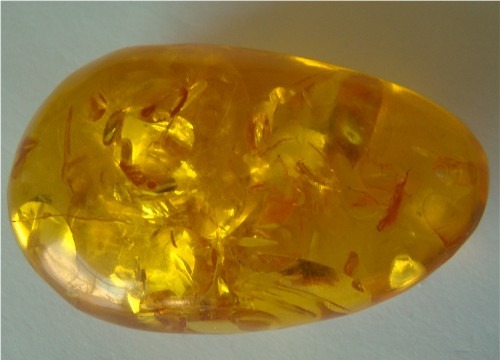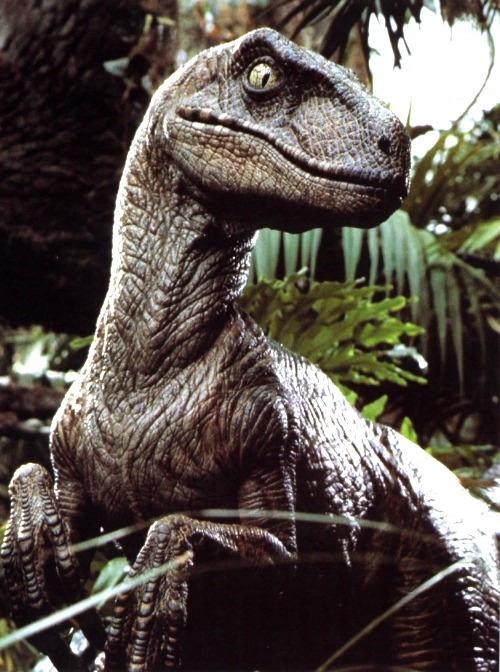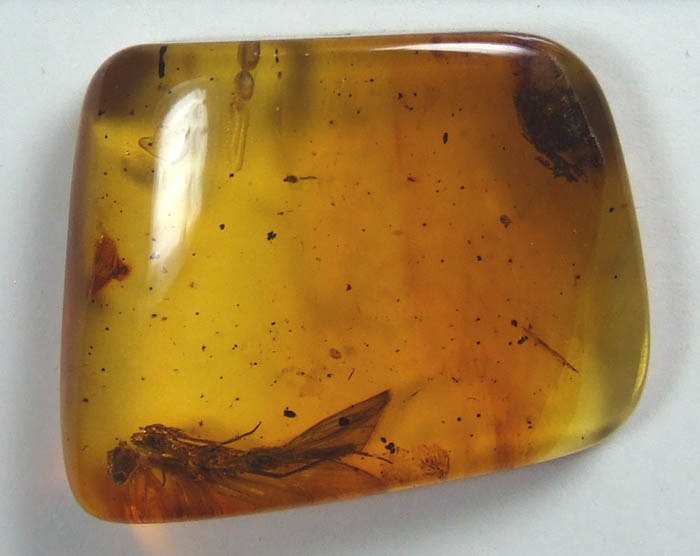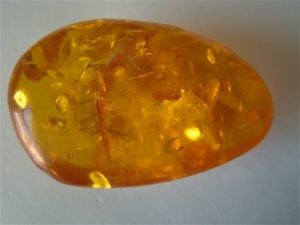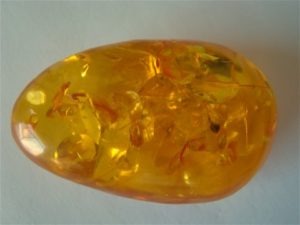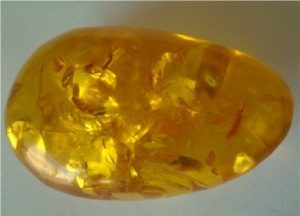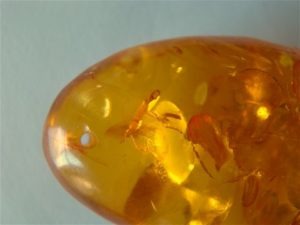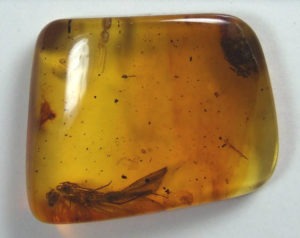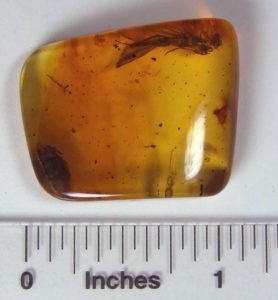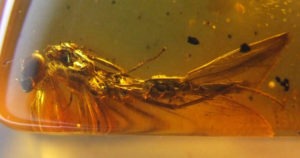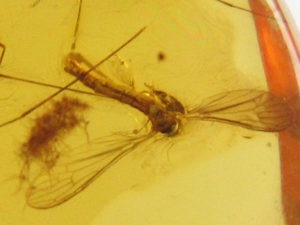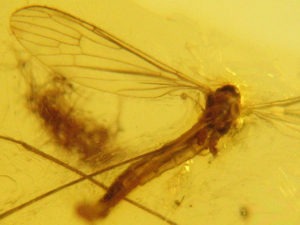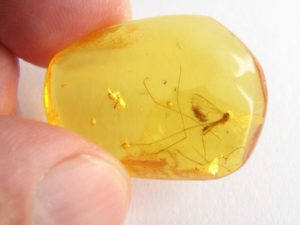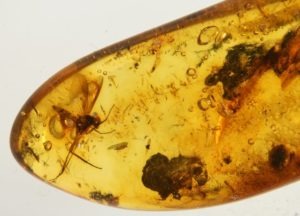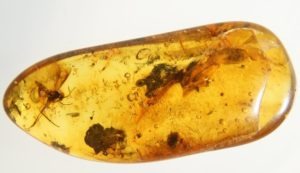Amber
Unlike other types of fossils, amber fossils are three-dimensional, with life-like colors and patterns. Even the internal structures of cells may be intact. Often, insects were caught by the resin in active poses, along with their predators, prey, and internal and external parasites. Many new species of fossilized insects have been discovered in amber. In some cases, deoxyribonucleic acid (DNA) can be taken from the entrapped organisms and studied. Amber with insect inclusions has become a popular material after it was shown as the source of the “Dinosaur DNA” in the movie “Jurassic Park”.
In about 500 B.C., the Greek philosopher Thales rubbed amber with silk, causing it to attract dust and feathers. This static electricity was believed to be a unique property of amber until the sixteenth century, when English scientist William Gilbert demonstrated that it was characteristic of numerous materials. He called it electrification, after elektron, the Greek word for amber.
Deposits of amber occur all over the world. Amber from the coast of the Baltic Sea (Baltic Amber) is the best- known. It is called Succinite Amber because it contains a substantial amount of succinic acid. Most Baltic amber came from pine tree resin. Amber that lacks succinic acid is classified as retinite amber. Baltic Amber is generally harder and more stable than Dominican Republic Amber
Amber from the Dominican Republic began forming 20-30 million years ago from the resins of extinct species of Hymenaea or algarrobo trees. These flowering trees thrived in the extensive tropical rain forests. They produced large amounts of resin that eventually hardened into amber. Heavy rains washed the amber to deltas where it was covered with silt. As sea levels changed, the amber settled on the sea floor and the sediment over it hardened into rock. Tectonic plate movement later formed mountains, pushing up the rocks. Dominican Amber is generally naturally clearer than Baltic Amber and is more sought after for insect inclusion specimens due to its natural clarity. It currently brings a higher price than the Baltic Amber.
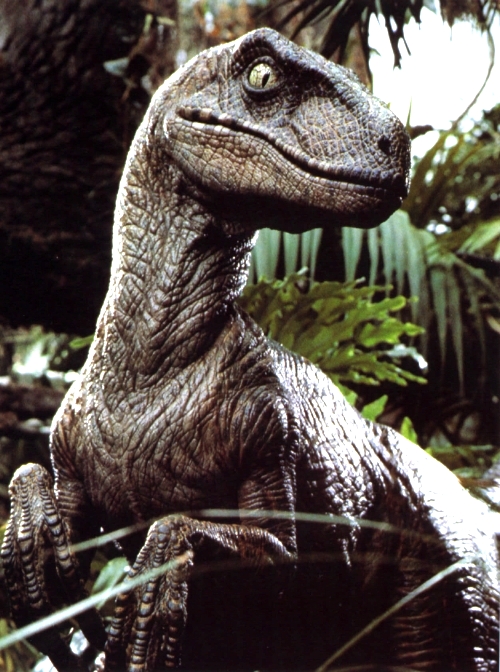
Amber is retrieved in different ways, depending on its location. Baltic amber washes up along the shores of the Baltic Sea and as far away as Denmark, Norway, and England. The largest deposits of North American amber are found on the surface of open pit clay mines in Arkansas. In New Jersey, Cretaceous amber is dug from the sand and clay of abandoned pit mines. In Asia, amber is found in coal mines. Until about 1950, premium amber was mined from excavated pits in northern Burma (Myanmar).
Amber is also known as; Agdsten, Ambar, Amber, Ambra, Ambre, Bernstein, Elektron, Freja's Tears, Fossil Resin, Fuling, Gintaras, Glessum, Hardened Honey, Harpaks, Lyncurum, Nordic Gold, Retinite, Succinite, Succinum, Sun Tears, Tears of the Heliades, Tiger's Soul and Yantar.
A copal is usually distinguishable from real amber by its lighter color and softness. Copal will hold a polish for a short period, and is sometimes sold as "amber". Africa, New Zealand and the Dominican Republic, Mexico and Columbia all produce Copal. True amber is also found in these areas.
Reconstituted amber, also known as “Ambroid”, “Processed”, “Pressed” or “Reconstructed Amber”, is made by fusing small pieces of amber under high pressure. There is nothing particularly wrong with reconstituted amber, but it is worth less than genuine amber. Reconstituted amber is characterized by either flow lines or somewhat artificial color. When gradually heated in an oil-bath, amber becomes soft and flexible. Two pieces of amber may be united by coating the surfaces with linseed oil, heating them, and then pressing them together while hot. Small fragments, formerly thrown away are now used in the formation of "ambroid" or "pressed amber". Pressed amber and "ambroid" (pieces of amber embedded in a plastic) are commonly found for sale as amber. Pressed amber is generally very even in color and is often found in commercially available Baltic amber jewelry. Natural amber is never as even colored as pressed amber. Reputable sellers will list whether amber is natural or reconstituted.
Amber specimens are often treated and stabilized to bring out luster and character. Amber is heated to change water bubbles to disc-oid fractures called "sun spangles". Cloudy amber, with tiny gas bubbles, may be clarified in a vacuum chamber by heating while it is immersed in oil.
If you are interested in learning more about amber here are a few recommended books; " Amber: The Golden Gem of the Ages", Patty C. Rice, The Kosciusko Foundation, 1980. (A very comprehensive reference book on amber)
"Amber: Window to the Past", David A. Grimaldi, American Museum of Natural History/H.N. Abrams 1996 (A good scientific reference with excellent photos)
Item# AMB0208003
Pressed and Clarified Baltic Amber

Polished, Pressed and Clarified Baltic Amber A beautiful golden color with a slight orange tint. This hand shaped amulet like nodule measures 2.25 x 1.4 x 0.8 inches (57 x 35 x 21mm). It has a hole drilled in the smaller end to accept jewelry cord or attachment. Nice cabinet display or wear it around your neck. Specimen shows "sun spangles" from the clarification process which add to its character.
Item # AMB0208002
Natural Baltic Amber with caddis fly inclusion (Insecta: Trichoptera) Kaliningrad region, Russia
$69.95

This is a very nice large gem quality piece of amber with a caddis fly inclusion (Trichoptera). This beautiful superior quality polished piece of amber can be enjoyed as is or made into a pendant or another piece of jewelry. The piece is flat on one side and slightly convex on the other. See pictures for the piece dimensions in inches (1 in = 25.4 mm). The natural color variations in true amber are clearly visible in this stunning specimen. This is one of the nicest specimens we have ever seen!
Item# AMB0308001
Natural Baltic Amber with Diptera (gnat) inclusion Palanga, Lithuania
$49.00

This polished specimen is Genuine, Authentic, and Natural Baltic Amber with a nice Diptera (gnat) inclusion. Nice clear specimen with slight internal natural fracture. A very nice light color with hints of orange on one edge.
Weighs 3.3 grams. Measurements: 28 x 21 x 9mm (length of insect body and head about 4mm). Color: Honey Origin & Location: Palanga, Lithuania.
Item # AMB0308002
Natural Baltic Amber with Multiple insect inclusions Palanga, Lithuania
$55.00

Excellent multiple insect inclusion Baltic Amber
This is an interesting specimen with a large Diptera (gnat) and smaller insect inclusions. This specimen also has trapped leaf parts and many air bubbles. Genuine, Authentic, and Natural Baltic Amber. Weighs 3.2 grams. Measurements: 37x16x8mm (length of insect body and head about 4mm). Color: Darker
Honey- Cognac. Origin & Location: Palanga, Lithuania.

